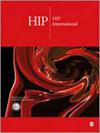Incidence of avascular necrosis of native femur following hip transposition surgery for periacetabular malignancies: a single-centre experience
IF 1.3
4区 医学
Q3 ORTHOPEDICS
引用次数: 0
Abstract
Background:Hip transposition surgery after surgical resection of large pelvic tumours is a well-established alternate to endoprosthetic reconstruction. The major goals of surgery are to ensure adequate resection margins with limb salvation, albeit with acceptable levels of morbidity. While surveillance is aimed at diagnosing local recurrence or distant metastasis primarily, other complications may occasionally be seen. The aim of this study was to assess incidence of avascular necrosis (AVN) in the preserved native femoral heads after hip transposition surgery for periacetabular malignancies, also known as hanging hip surgery.Patients and methods:Patient records and follow-up imaging of 22 patients who had undergone hanging hip surgery from 1999 to 2020 were retrospectively analysed to assess for any probable causes of AVN.Results:Of the 22 patients, 5 (22.7%) had developed AVN on follow-up with a mean time of onset of about 10.5 months from surgery (5 months–2 years). A review of the patient demographics, surgical notes, preoperative management did not offer any clues as to the cause of AVN in these patients. Osteopenia was the most common radiological finding (59%) in most patients, but this also did not herald AVN onset.Conclusions:The theory that loss of major vascular supply to the femoral head from capsular disruption during hip transposition surgery would lead to AVN in most patients did not hold true as AVN occurred in a small number of patients.髋关节置换手术治疗髋臼周围恶性肿瘤后原发性股骨无血管性坏死的发生率:单中心经验
背景:盆腔巨大肿瘤切除术后的髋关节转位手术是一种行之有效的替代假体内重建手术的方法。手术的主要目标是确保足够的切除边缘,同时保留肢体,尽管发病率在可接受的水平。虽然监测的主要目的是诊断局部复发或远处转移,但偶尔也会出现其他并发症。本研究旨在评估髋关节周围恶性肿瘤髋关节转位手术(也称悬吊髋关节手术)后保留的原位股骨头血管性坏死(AVN)的发生率。患者和方法:对1999年至2020年期间接受悬吊髋关节手术的22名患者的病历和随访影像进行了回顾性分析,以评估导致AVN的可能原因。结果:在22名患者中,有5人(22.7%)在随访中出现了AVN,平均发病时间为手术后约10.5个月(5个月至2年)。对患者的人口统计学特征、手术记录和术前处理进行回顾后,并未发现导致这些患者发生 AVN 的任何线索。结论:在髋关节转位手术中,股骨头的主要血管供应因关节囊破坏而丧失,这将导致大多数患者出现股骨头坏死,但这一理论并不成立,因为只有少数患者出现了股骨头坏死。
本文章由计算机程序翻译,如有差异,请以英文原文为准。
求助全文
约1分钟内获得全文
求助全文
来源期刊

HIP International
医学-整形外科
CiteScore
4.20
自引率
0.00%
发文量
70
审稿时长
2 months
期刊介绍:
HIP International is the official journal of the European Hip Society. It is the only international, peer-reviewed, bi-monthly journal dedicated to diseases of the hip. HIP International considers contributions relating to hip surgery, traumatology of the hip, prosthetic surgery, biomechanics, and basic sciences relating to the hip. HIP International invites reviews from leading specialists with the aim of informing its readers of current evidence-based best practice.
The journal also publishes supplements containing proceedings of symposia, special meetings or articles of special educational merit.
HIP International is divided into six independent sections led by editors of the highest scientific merit. These sections are:
• Biomaterials
• Biomechanics
• Conservative Hip Surgery
• Paediatrics
• Primary and Revision Hip Arthroplasty
• Traumatology
 求助内容:
求助内容: 应助结果提醒方式:
应助结果提醒方式:


